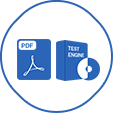Last Update 5 hours ago Total Questions : 387
The Google Professional Data Engineer Exam content is now fully updated, with all current exam questions added 5 hours ago. Deciding to include Professional-Data-Engineer practice exam questions in your study plan goes far beyond basic test preparation.
You'll find that our Professional-Data-Engineer exam questions frequently feature detailed scenarios and practical problem-solving exercises that directly mirror industry challenges. Engaging with these Professional-Data-Engineer sample sets allows you to effectively manage your time and pace yourself, giving you the ability to finish any Google Professional Data Engineer Exam practice test comfortably within the allotted time.
You have two projects where you run BigQuery jobs:
• One project runs production jobs that have strict completion time SLAs. These are high priority jobs that must have the required compute resources available when needed. These jobs generally never go below a 300 slot utilization, but occasionally spike up an additional 500 slots.
• The other project is for users to run ad-hoc analytical queries. This project generally never uses more than 200 slots at a time. You want these ad-hoc queries to be billed based on how much data users scan rather than by slot capacity.
You need to ensure that both projects have the appropriate compute resources available. What should you do?
You have one BigQuery dataset which includes customers' street addresses. You want to retrieve all occurrences of street addresses from the dataset. What should you do?
You have historical data covering the last three years in BigQuery and a data pipeline that delivers new data to BigQuery daily. You have noticed that when the Data Science team runs a query filtered on a date column and limited to 30–90 days of data, the query scans the entire table. You also noticed that your bill is increasing more quickly than you expected. You want to resolve the issue as cost-effectively as possible while maintaining the ability to conduct SQL queries. What should you do?
You are building an ELT solution in BigQuery by using Dataform. You need to perform uniqueness and null value checks on your final tables. What should you do to efficiently integrate these checks into your pipeline?
You work for a shipping company that has distribution centers where packages move on delivery lines to route them properly. The company wants to add cameras to the delivery lines to detect and track any visual damage to the packages in transit. You need to create a way to automate the detection of damaged packages and flag them for human review in real time while the packages are in transit. Which solution should you choose?
Cloud Bigtable is Google's ______ Big Data database service.
What is the HBase Shell for Cloud Bigtable?

